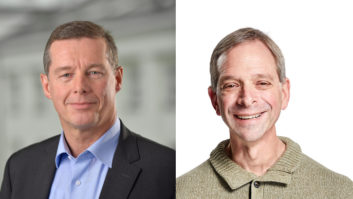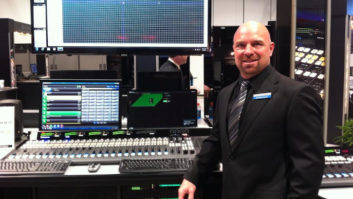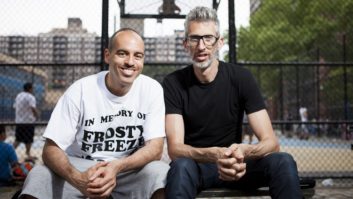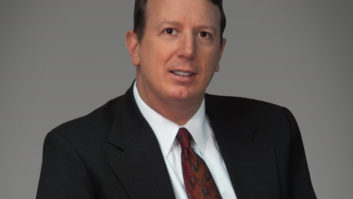The spring NAB Show is approaching. Between now and then Radio World will conduct several short Q&As with manufacturers about their plans and offerings, to help you get the most out of the big annual trade show. Peter Howarth is business coordinator at AEQ’s U.S. operation, AEQ Broadcast International Inc.

Radio World: How has business been for the company since last year’s NAB show?
Peter Howarth: We continue with our trend and are consolidating our presence in our traditional markets, while simultaneously increasing the number of markets in which we are present. We have been reorganizing our distribution in North America with the relaunch of our operation in Mexico, led by César Reyna, as well as our United States office. It has been a logical reshuffling in regards to how we are addressing the North, Central American and Caribbean markets. In parallel to this, we have entered and are seeking strategic partnerships for these markets related to the convergence of broadcast equipment and IP technologies. One example is our recent agreement with Broadcast Pix in Massachusetts for broadcast automation processes such as visual radio.
[Read: Radio Agricultura Renews With AEQ Systel IP]
RW: What are you hearing from your customers about their business outlook this year? In what areas should we expect growth or the most interesting projects?
Howarth: The convergence of equipment and services based on IP will continue. We saw the tendency last year and this year the trend will most certainly continue with interesting projects in the Mexican and Brazilian markets. Scalable and flexible IP-based systems that provide both resource and format sharing in tandem with comprehensive operation and control will be areas of market growth.
RW: You’ve been active in the broadcast studio market for 37 years. What’s the biggest problem or challenge facing users in this segment right now?
Howarth: Workflow integration of solutions for the operation and control of all equipment encompassed in any system. This does not necessarily imply a one-stop shop but rather the possibility of being able to shop anywhere with a guarantee that the final solution for the system integration will work. As already mentioned, equipment interoperability and management standards are becoming critical to customers.
RW: What new goodies will your company be showing? Why should attendees visit your booth C3651?
Howarth: We will be showing SystelSet+, a completely new control panel for our talk show system, Systel IP. Also, we are going to display new equipment with AoIP connectivity together with our latest advances, NetBox DSP and Matrix, for our already existing range of such equipment. These include specific operational functions for our intercom systems, mixing consoles Forum IP, Forum Split IP and Capitol IP and new developments that are part of our global solutions.
[Read: AEQ Upgrades Forum and Capitol]
We will demonstrate how to best rely on a common infrastructure for different functions. Visitors to our stand will also be able to see that equipment infrastructure has mixed functionality like for example, visual radio. That is, audio mixing consoles, AoIP interfaces, intercom user panels, commentary units such as the Olympia 3 and audio codecs are connected to the same router, creating a global, flexible, and if required, redundant system. All this is benefiting from the simplicity and flexibility IP technology provides in terms of wiring, for example. The result is an audio quality that was previously only reserved for contribution and broadcasting.
RW: What specific challenges and/or developments do you expect in your markets in 2018?
Howarth: The challenges are intrinsic to the markets. Latin America is a traditional market for AEQ since we are Spanish. That does not necessarily mean that we have an advantage compared to other companies, however. On the contrary, we have to overcome a geographical barrier that is the Atlantic and the related time zones. We have had a U.S. operation since 1994 and this is now reinforced with our Mexico office. The North and Central American and Caribbean markets are now much more accessible to us from these locations, and our initiated reorganization of our distribution for these markets will certainly see a lot of development in the forthcoming months. In this ever-shrinking world in terms of communications, one thing that we have found is that the customers like to have proximity to their suppliers.
RW: What do you anticipate will be the most significant technology trend at NAB 2018?
Howarth: AEQ thinks the trend in system convergence through IP technologies will continue and we will see further system integration becoming increasingly necessary. Global solutions are now becoming paramount for operators in media markets. Equipment interoperability and global system solutions for operation and control are needed more and more so this will be something to look out for at the NAB.
RW: Will you be attending any sessions or looking forward to any events?
Howarth: Personally I would love to attend the “Business of Sports Entertainment” sessions, as well as the other events taking place at the Main Stage. As an exhibitor, however, we have very limited options for attending sessions or events. We are normally too busy trying to keep up with our visitors. Take into account that every handshake at NAB is really expensive so our effort is on the ROI — doing everything to avoid potential customers from “slipping through the net.” We need to meet them, talk to them, and listen to what they have to say. We have people form our marketing and R&D department with us of course, and they normally spend time looking at the trends and innovations.
RW: You’re a show veteran, how has the show changed since your first visit?
Howarth: Pfffffff. AEQ exhibited in Atlanta and is definitely a veteran. I personally have been attending the NAB Show since 1993. For me, the main change has been the way we communicate and get exposure. The real revolution in this respect took place not so long ago, with the introduction of smartphones some 12 years ago. All of a sudden everything started networking and became so much easier, so many more possibilities. Just look at the number of sessions and events. To be honest I don’t believe that the show has grown in visitors but a lot more so in exhibiting companies and this is certainly due to the evolution of technology. Today, broadcasting technology is cross-platform rather than the once highly specialized technology for radio and television and encompasses a myriad of challenges and opportunities.
RW: This year show organizers have done some serious rearranging of the venue, expanded thematic items like pavilions and put emphasis on events and activities such as Main Stage. Any thoughts on that?
Howarth: We applaud any efforts that assist visitors to optimize quality time at this show. As we see it, it is apparent the show has grown in number of exhibitors. If, as a visitor a broadcaster that wants to use NAB to keep abreast with both technology and trends, it will be a really tough week. If you are a small- to medium-sized broadcaster, you also have the issue of the amount of resources you are able to deploy for a show like this. For AEQ, the choice of exhibit space is becoming more and more critical. You need to be close to the events that are generating general visitor traffic.












